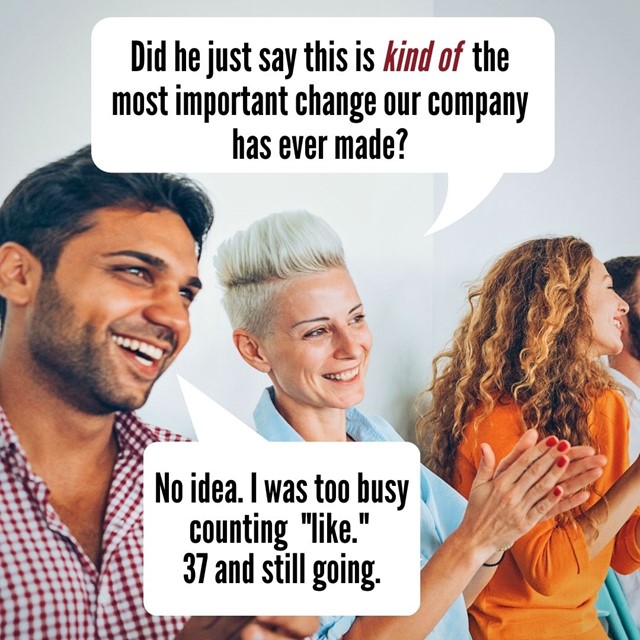
It's fairly common for speakers to ask us for help in reducing their uhs and ums. There are other fillers that speakers don't realize they use - and these are often even more troubling.
Of course, filler isn't all bad, as this article points out. But when a speaker peppers a talk or conversation with them, audiences tell us they zero in on the filler. They find it distracting, at best. Sometimes, it's rated as downright annoying.
Here are three types we hear frequently from students who come through our programs, some thoughts on why you might benefit from limiting them, and tips from our experience on how you can cut them out.
The check-in: Right? Okay?
Some presenters will follow a statement with a one-word question to check for understanding. Usually, they say Right? or Okay?
This impulse to check in comes from a good place. The speaker wants to be sure they've made themselves clear, that the information is something the audience gets, sees, or appreciates.
The effect when it's used often, though, is not always positive. When a speaker checks in a lot, it can suggest they think the audience is not too bright. Or that they are a poor speaker who has trouble getting their ideas across.
Said at the end of nearly every statement, this filler also suggests the speaker isn't genuinely checking in. It's fairly clear this is a verbal tic they're either unaware of or unable to control.
To reduce your use:
- Start by recognizing it. Watch a recording of yourself, read a transcript, or ask a colleague to monitor you.
- Try eliminating the filler word and pausing silently instead.
- Consider why you're using it: Are your sentences too long? Are you making your messages too complex? Do you lack confidence in your ability to make something clear? Try to solve that problem before your next talk.
The spring chicken: Like, you know, I mean
Certain filler phrases are associated with immaturity. Not a fair assessment, most certainly, for we hear speakers of every age and experience use these fillers a lot.
Regardless, disrupting what could be a simple statement with spring chicken filler is unsavory for audiences of every age : I mean, like, what is, you know, the problem, like, with that?
"Just spit it out," audiences tell us is their reaction - even when the same audience members are guilty of using this kind of filler themselves.
To reduce these filler words:
- Listen to yourself, even in casual conversation. Reduce your use across the board.
- Record and transcribe a presentation. Use word search to highlight how and where you use it.
- Script part of a presentation and practice delivering your script. Work at breaking up the phrasing patterns that let these filler words creep in. Link words and ideas that should flow together; pause for a purpose.
The hedge: Kind of, sorta, I guess
Even some of the most impressive people we know resort to this third category of filler. We've heard strong leaders from large companies say things along the lines of: "It’s kind of the most important change we've made in the history of our company, I guess."
What's happening there? An otherwise strong statement is getting watered down with wishy-washy language.
Why is it happening? That could be the more important question. Speakers tell us they use these phrases because they don't want to seem over-certain or arrogant.
Still, the result is not helpful. We know the speaker knows: This is the most important change we’ve made in the history of our company. Or at least: This could be the most important change we’ve made in the history of our company.
But not kinda, sorta, maybe. There is a difference.
To reduce unproductive hedging:
- Identify your tendency to use these words and notice when you're most likely to use them - so you can plan to eliminate them.
- Be deliberate in how you qualify your statements. Don't let these fillers become your default expression.
- Ask a colleague to listen and let you know when you fall into this pattern so you can stop immediately. Sometimes, colleagues work out a simple signal they can use—a touch to the nose or chin, for example—to cue "you’re doing it again."
What about uh and um?
We're fans of limiting those, too, though a few uhs and ums won't wreck a presentation. We've also learned over the years that there are speakers who use these sounds for constructive purposes—because English is their second language, for instance, or because it's how they manage a stutter.
Still, a barrage of uhs and ums can be problematic. So if you'd like to limit those, we've got a few suggestions here.






